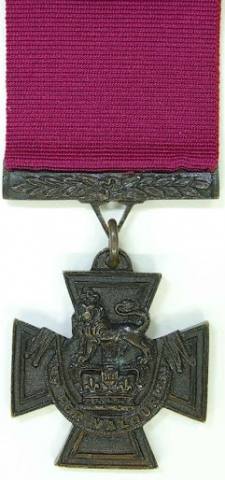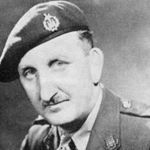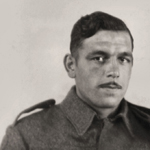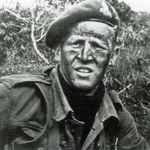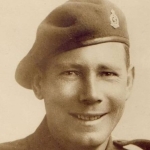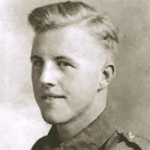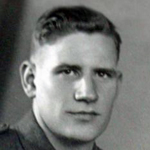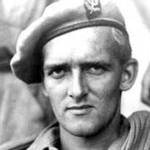Commandos awarded the Victoria Cross
Primary tabs
Eight Commandos were awarded the Victoria Cross.
The Victoria Cross was instituted by Royal Warrant on 29 January 1856 for award to both officers and non-commissioned ranks of the Royal Navy and the Army who in the presence of the enemy “shall have performed some single act of valour”. Simple in design, the cross is made from the bronze cannon captured during the Crimean War 1854 - 1856. Subsequently the Victoria Cross has been awarded to persons of any rank in any service including the Royal Air Force, Commonwealth Forces, and Civilians operating under military command.Geoffrey Charles Tasker Keyes VC MC
Major (Temporary Lieutenant Colonel) No. 11 Commando Date of operation: 18 November 1941. Archive record [view]. War Office, 19th June, 1942. Lieutenant-Colonel Keyes commanded a detachment of a force which landed some 250 miles behind the enemy lines to attack Headquarters, Base Installations and Communications. From the outset Lieutenant-Colonel Keyes deliberately selected for himself the command of the detachment detailed to attack what was undoubtedly the most hazardous of these objectives—the residence and Headquarters of the General Officer Commanding the German forces in North Africa. This attack, even if initially successful, meant almost certain death for those who took part in it. He led his detachment without guides, in dangerous and precipitous country and in pitch darkness, and maintained by his stolid determination and powers of leadership the morale of the detachment. He then found himself forced to modify his original plans in the light of fresh information elicited from neighbouring Arabs, and was left with only one officer and an N.C.O. with whom to break into General Rommel's residence and deal with the guards and Headquarters Staff. At zero hour on the night of 17th-18th November, 1941, having despatched the covering party to block the approaches to the house, he himself with the two others crawled forward past the guards, through the surrounding fence and so up to the house itself. Without hesitation, he boldly led his party up to the front door, beat on the door and demanded entrance. Unfortunately, when the door was opened, it was found impossible to overcome the sentry silently, and it was necessary to shoot him. The noise of the shot naturally aroused the inmates of the house and Lieutenant-Colonel Keyes, appreciating that speed was now of the utmost importance, posted the N.C.O. at the foot of the stairs to prevent interference from the floor above. Lieutenant-Colonel Keyes, who instinctively took the lead, emptied his revolver with great success into the first room and was followed by the other officer who threw a grenade. Lieutenant-Colonel Keyes with great daring then entered the second room on the ground floor but was shot almost immediately on flinging open the door and fell back into the passage mortally wounded. On being carried outside by his companions he died within a few minutes. By his fearless disregard of the great dangers which he ran and of which he was fully aware, and by his magnificent leadership and outstanding gallantry, Lieutenant-Colonel Keyes set an example of supreme self sacrifice and devotion to duty.Augustus Charles Newman VC
Lieutenant Colonel No. 2 Commando Date of operation: 27/28 March 1942 Archive record [view]. War Office, 19th June, 1945.On the night of 27th/28th March, 1942, Lieutenant-Colonel Newman was in command of the military force detailed to land on enemy occupied territory and destroy the dock installations of the German controlled naval base at St. Nazaire. This important base was known to be heavily defended and bomber support had to be abandoned owing to bad weather. The operation was therefore bound to be exceedingly hazardous, but Lieutenant-Colonel Newman, although empowered to call off the assault at any stage, was determined to carry to a successful conclusion the important task which had been assigned to him.
Coolly and calmly he stood on the bridge of the leading craft, as the small force steamed up the estuary of the River Loire, although the ships had been caught in the enemy searchlights and a murderous crossfire opened from both banks, causing heavy casualties.
Although Lieutenant-Colonel Newman need not have landed himself, he was one of the first' ashore and, during the next five hours of bitter fighting, he personally entered several houses and shot up the occupants and supervised the operations in the town, utterly regardless of his own safety, and he never wavered in his resolution to carry through the operation upon which so much depended.
An enemy gun position on the roof of a U-boat pen had been causing heavy casualties to the landing craft and Lieutenant- Colonel Newman directed the fire of a mortar against this position to such effect that the gun was silenced. Still fully exposed, he then brought machine gun fire to bear on an armed trawler in the harbour, compelling it to withdraw and thus preventing many casualties in the main demolition area.
Under the brilliant leadership of this officer the troops fought magnificently and held vastly superior enemy forces at bay, until the demolition parties had successfully completed their work of destruction. By this time, however, most of the landing craft had been sunk or set on fire and evacuation by sea was no longer possible.
Although the main objective had been achieved, Lieutenant-Colonel Newman nevertheless was now determined to try and fight his way out into open country and so give all survivors a chance to escape. The only way out of the harbour area lay across a narrow iron bridge covered by enemy machine guns and although severely shaken by a German hand grenade, which had burst at his feet, Lieutenant-Colonel Newman personally led the charge which stormed the position and under his inspiring leadership 'the small force fought its way through the streets to a point near the open country, when, all ammunition expended, he and his men were finally overpowered by the enemy.
For the outstanding gallantry and devotion to duty of this fearless officer, his brilliant leadership and initiative, were largely responsible for the success of this perilous operation which resulted in heavy damage to the important naval base at St. Nazaire.
Thomas Frank Durrant VC
Sergeant No. 1 Commando Date of operation: 27/28 March 1942 Archive Record [view]. War Office 19th June 1945.For great gallantry, skill and devotion to duty when in charge of a Lewis gun in H.M. Motor Launch 306 in the St. Nazaire raid on the 28th March, 1942.
Motor Launch 306 came under heavy fire while proceeding up the River Loire towards the port. Sergeant Durrant, in his position abaft the bridge, where he had no cover or protection, engaged enemy gun positions and searchlights on shore. During this engagement he was severely wounded in the arm but refused to leave his gun.
The Motor Launch subsequently went down the river and was attacked by a German destroyer at 50-60 yards range, and often closer. In this action Sergeant Durrant continued to fire at the destroyer's bridge with the greatest coolness and with complete disregard of the enemy's fire. The Motor Launch was illuminated by the enemy searchlight and Sergeant Durrant drew on himself the individual attention of the enemy guns, and was again wounded, in many places.
Despite these further wounds he stayed in his exposed position, still firing his gun, although after a time only able to support himself by holding on to the gun mounting. After a running fight, the Commander of the German destroyer called on the Motor Launch to surrender. Sergeant Durrant's answer was a further burst of fire at the destroyer's bridge. Although now very weak he went on firing, using drums of ammunition as fast as they could be replaced.
A renewed attack by the enemy vessel eventually silenced the fire of the Motor Launch but Sergeant Durrant refused to give up until the destroyer came alongside, grappled the Motor Launch and took prisoner those who remained alive.
Sergeant Durrant's gallant fight was commended by the German officers on boarding the Motor Launch.
This very gallant Non-Commissioned Officer later died.
Patrick Anthony Porteous VC
Lieutenant (Temporary Captain)* No. 4 Commando Date of operation: 19 August 1942 Archive record [view]. War Office, 2nd October 1942.At Dieppe on the 19th August, 1942, Captain Porteous was detailed to act as Liaison Officer between the two detachments whose task was to assault the heavy coast defence guns. In the initial assault Captain Porteous, working with the smaller of the two detachments, was shot at close range through the hand, the bullet passing through his palm and entering his upper arm. Undaunted, Captain Porteous closed with his assailant, succeeded in disarming him and killed him with his own bayonet thereby saving the life of a British Sergeant on whom the German had turned his aim.
In the meantime the larger detachment was held up, and the officer leading this detachment was killed and the Troop Sergeant-Major fell seriously wounded. Almost immediately afterwards the only other officer of the detachment was also killed. Captain Porteous, without hesitation and in the face of a withering fire, dashed across the open ground to take over the command of this detachment. Rallying them, he led them in a charge which carried the German position at the point of the bayonet, and was severely wounded for the second time. Though shot through the thigh he continued to the final objective where he eventually collapsed from loss of blood after the last of the guns had been destroyed.
Captain Porteous's most gallant conduct, his brilliant leadership and tenacious devotion to a duty which was supplementary to the role originally assigned to him, was an inspiration to the whole detachment.
*Rank as amended in LG entry 6th October 1942.
Henry Eric Harden VC
Lance Corporal No. 45 Royal Marine Commando, RM. Date of operation: 23 January 1945 Archive record [view]. War Office, 8th March, 1945. In North-West Europe on 23rd January, 1945 the leading section of a Royal Marine Commando Troop having come under intense machine-gun fire was ordered to make for some houses close by. Four of the section had been wounded and were left lying in the open. Under continuous fire Lance Corporal Harden at once went forward and with great coolness and bravery attended to the four casualties. He then carried one of them back to cover. He was ordered not to go forward again and an attempt was made to bring in the remaining casualties with the aid of tanks, but this proved unsuccessful owing to the heavy and accurate fire of anti-tank guns.A second attempt under a smoke-screen also proving unsuccessful, Lance Corporal Harden insisted in going forward with a volunteer stretcher party and succeeded in bringing back another badly wounded man. He went out a third time, and whilst returning with the stretcher party, he was killed.
Throughout this long period Lance Corporal Harden displayed superb devotion to duty and personal courage of the highest order.
His action was directly responsible for saving the lives of the wounded brought in, while his complete contempt for all personal danger, and the magnificent example he set of cool courage and determination to continue with his work, whatever the odds, was an inspiration to his comrades and will never be forgotten by those who saw it.
George Arthur Knowland VC
Lieutenant No. 1 Commando Date of operation: 31 January 1945 Archive record [view]. War Office, 12th April 1945. In Burma on 31st January, 1945, near Kangaw, Lieutenant Knowland was commanding the forward platoon of a Troop positioned on the extreme North of a hill which was subjected to very heavy and repeated enemy attacks throughout the whole day. Before the first attack started, Lieutenant Knowland's platoon was heavily mortared and machine gunned, yet he moved about among his men keeping them alert and encouraging them, though under fire himself at the time. When the enemy, some 300 strong in all, made their first assault they concentrated all their efforts on his platoon of 24 men, but, in spite of the ferocity of the attack, he moved about from trench to trench distributing ammunition, and firing his rifle and throwing grenades at the enemy, often from completely exposed positions.Later, when the crew of one of his forward Bren Guns had all been wounded, he sent back to Troop Headquarters for another crew and ran forward to man the gun himself until they arrived. The enemy was then less than 10 yards from him in dead ground down the hill, so, in order to get a better field of fire, he stood on top of the trench, firing the light machine gun from his hip, and successfully keeping them at a distance until a Medical Orderly had dressed and evacuated the wounded men behind him. The new Bren team also became casualties on the way up, and Lieutenant Knowland continued to fire the gun until another team took over.
Later, when a fresh attack came in, he took over a 2 in. Mortar and in spite of heavy fire and the closeness of the enemy, he stood up in the open to face them, firing the mortar from his hip and killing six of them with his first bomb. When all bombs were expended he went back through heavy grenade, mortar and machine gun fire to get more, which he fired in the same way from the open in front of his platoon positions. When those bombs were finished, he went back to his own trench, and still standing up fired his rifle at them. Being hard pressed and with enemy closing in on him from only 10 yards away, he had no time to re-charge his magazine. Snatching up the Tommy gun of a casualty, he sprayed the enemy and was mortally wounded stemming this assault, though not before he had killed and wounded many of the enemy.
Such was the inspiration of his magnificent heroism, that, though fourteen out of twenty four of his platoon became casualties at an early stage, and six of his positions were over-run by the enemy, his men held on through twelve hours of continuous and fierce fighting until reinforcements arrived. If this Northern end of the hill had fallen, the rest of the hill would have been endangered, the beach-head dominated by the enemy, and other units farther inland cut off from their source of supplies. As it was, the final successful counter-attack was later launched from the vital ground which Lieutenant Knowland had taken such a gallant part in holding.
Thomas Peck Hunter VC
Corporal No. 43 Royal Marine Commando, RM Date of operation: 3 April 1945 Archive record [view]. Admiralty Whitehall 12th June 1945.In Italy during the advance by the Commando to its final objective, Corporal Hunter of "C" Troop was in charge of a Bren group of the leading sub section of the Commando. Having advanced to within 400 yards of the canal, he observed the enemy were holding a group of houses South of the canal. Realising that his Troop behind him were in the open, as the country there was completely devoid of cover, and that the enemy would cause heavy casualties as soon as they opened fire, Corporal Hunter seized the Bren gun and charged alone across two hundred yards of open ground. Three Spandaus from the houses, and at least six from the North bank of the canal opened fire and at the same time the enemy mortars started to fire at the Troop.
Corporal Hunter attracted most of the fire, and so determined was his charge and his firing from the hip that the enemy in the houses became demoralised. Showing complete disregard for the intense enemy fire, he ran through the houses, changing magazines as he ran, and alone cleared the houses. Six Germans surrendered to him and the remainder fled across a footbridge onto the North bank of the canal. The Troop dashing up behind Corporal Hunter now became the target for all the Spandaus on the North of the canal. Again, offering himself as a target, he lay in full view of the enemy on a heap of rubble and fired at the concrete pillboxes on the other side. He again drew most of the fire, but by now the greater part of the Troop had made for the safety of the houses. During this period he shouted encouragement to the remainder, and called only for more Bren magazines with which he could engage the Spandaus. Firing with great accuracy up to the last, Corporal Hunter was finally hit in the head by a burst of Spandau fire and killed instantly.
There can be no doubt that Corporal Hunter offered himself as a target in order to save his Troop, and only the speed of his movement prevented him being hit earlier. The skill and accuracy with which he used his Bren gun is proved by the way he demoralised the enemy, and later did definitely silence many of the Spandaus firing on his Troop as they crossed open ground, so much so that under his covering fire elements of the Troop made their final objective before he was killed.
Throughout the operation his magnificent courage, leadership and cheerfulness had been an inspiration to his comrades.
Anders Frederick Emil V. Schau Lassen VC, MC
Major Special Boat Service, SAS Regiment, AAC, attached 2 Commando Brigade Date of operation: 9 April 1945 Archive record [view]. War Office, 7th September, 1945.In Italy, on the night of 8th/9th April, 1945, Major Lassen was ordered to take out a patrol of one officer and seventeen other ranks to raid the north shore of Lake Comacchio. His tasks were to cause as many casualties and as much confusion as possible, to give the impression of a major landing, and to capture prisoners.
No previous reconnaissance was possible, and the party found itself on a narrow road flanked on both sides by water. Preceded by two scouts, Major Lassen led his men along the road towards the town. They were challenged after approximately 500 yards from a position on the side of the road. An attempt to allay suspicion by answering that they were fishermen returning home failed, for when moving forward again to overpower the sentry, machine gun fire started from the position, and also from two other blockhouses to the rear. Major Lassen himself then attacked with grenades, and annihilated the first position containing four Germans and two machine guns. Ignoring the hail of bullets sweeping the road from three enemy positions, an additional one having come into action from 300 yards down the road, he raced forward to engage the second position under covering fire from the remainder of the force. Throwing in- more grenades he silenced this position which was then overrun by his patrol. Two enemy were killed, two captured and two more machine-guns silenced. By this time the force had suffered casualties and its fire power was very considerably considerably reduced.
Still under a heavy cone of fire Major Lassen rallied and reorganised his force and brought his fire to bear on the third position. Moving forward himself he flung in more grenades which produced a cry of " Kamerad ". He then went forward to within three or four yards of the position to order the enemy outside, and to take their surrender. Whilst shouting to them to come out he was hit by a burst of spandau fire from the left of the position and he fell mortally wounded, but even whilst falling he flung a grenade, wounding some of the occupants, and enabling his patrol to dash in and capture this final position.
Major Lassen refused to be evacuated as he said it would impede the withdrawal and endanger further lives, and as ammunition was nearly exhausted the force had to withdraw. By his magnificent leadership and complete disregard for his personal safety, Major Lassen had, in the face of overwhelming superiority, achieved his objects. Three positions were wiped out, accounting for six machine guns, killing eight and wounding others of the enemy, and two prisoners were taken. The high sense of devotion to duty and the esteem in which he was held by the men he led, added to his own magnificent courage, enabled Major Lassen to carry out all the tasks he had been given with complete success.
Return to the CVA Homepage HERE.
Ask Questions / Add Information / Add Photos
Read some frequently asked questions here [FAQ's].


